EPF Passbook: Understanding Provident Fund Transaction Records with Ease
For Indian salaried individuals, the Employee Provident Fund (EPF) serves as a crucial retirement savings scheme. It fosters financial security post-retirement by accumulating contributions from both employee and employer over the course of employment. To track these contributions and gain insights into your EPF account, the Employees’ Provident Fund Organisation (EPFO) provides a comprehensive EPF passbook.
Decoding Your EPF Passbook: A Breakdown of Key Sections
Understanding your Employee Provident Fund passbook can be daunting at first glance. However, dissecting its key sections simplifies the process and empowers you to make informed decisions about your retirement savings.
- Member Details: This section displays your basic information, including name, date of birth, Universal Account Number (UAN), and Member ID. It serves as a quick reference point for verifying your identity and account details.
- Opening Balance: This reflects the total amount accumulated in your Employee Provident Fund account at the beginning of the chosen period, usually a financial year.
- Monthly Contributions: This section details the monthly contributions made towards your Employee Provident Fund account throughout the year. It includes contributions from both you and your employer, expressed as a percentage of your basic salary.
- Interest Earned: The EPFO credits interest on your Employee Provident Fund balance annually. This section showcases the interest earned on your contributions for the chosen period.
- Refunds and Withdrawals: If you have opted for any refunds or withdrawals from your Employee Provident Fund account, they will be reflected in this section along with the corresponding dates and amounts.
- Closing Balance: This represents the final amount in your Employee Provident Fund account at the end of the chosen period, calculated by adding the opening balance, monthly contributions, interest earned, and subtracting any refunds or withdrawals.
Beyond the Basics: Unlocking Additional Information
Your Employee Provident Fund passbook offers valuable insights beyond just basic transaction records. Here’s how to delve deeper:
- Scheme-wise Breakdown: The passbook often provides a breakdown of your contributions and closing balance across different schemes within the Employee Provident Fund corpus, such as the Employees’ Pension Scheme (EPS) and the Employee Deposit Linked Insurance Scheme (EDLI).
- Investment Details: The EPFO invests a portion of your Employee Provident Fund contributions in various instruments. Your passbook may disclose details about these investments, offering a glimpse into the diversification and potential returns of your retirement corpus.
- Employer Information: This section usually displays your employer’s name and code, allowing you to cross-check the accuracy of their contributions to your EPF account.
Leveraging Your EPF Passbook for Informed Decisions
A thorough understanding of your Employee Provident Fund passbook empowers you to make informed decisions about your retirement savings. Here’s how:
- Track your progress: Regularly reviewing your passbook helps you monitor your Employee Provident Fund contributions and closing balance, ensuring they align with your expectations.
- Identify discrepancies: If you notice any discrepancies in your passbook entries, such as missing contributions or incorrect amounts, you can promptly raise them with the EPFO for rectification.
- Plan for retirement: By understanding your current Employee Provident Fund corpus and projected future contributions, you can make informed decisions about additional investments or adjustments to your retirement planning strategy.
Accessing Your Employee Provident Fund Passbook: A Digital Transformation
The EPFO has embraced digitalization, making your Employee Provident Fund passbook readily accessible through the Umang app and the EPFO member portal. These platforms allow you to:
- View your passbook anytime, anywhere.
- Download and share your passbook electronically.
- Track your Employee Provident Fund contributions in real-time.
- Raise queries and access various EPFO services.
Conclusion: Your EPF Passbook – A Key to Financial Security
Your Employee Provident Fund passbook serves as a valuable tool for understanding and managing your retirement savings. By deciphering its sections, leveraging its insights, and accessing it conveniently through digital platforms, you can take control of your financial future and secure a comfortable retirement. Remember, regular monitoring and informed decision-making are key to maximizing the benefits of your Employee Provident Fund contributions and ensuring a financially secure future.
Sources:
- Employees’ Provident Fund Organisation: https://www.epfindia.gov.in/
- Umang App: https://play.google.com/store/apps/details?id=in.gov.umang.negd.g2c&hl=en&gl=US




